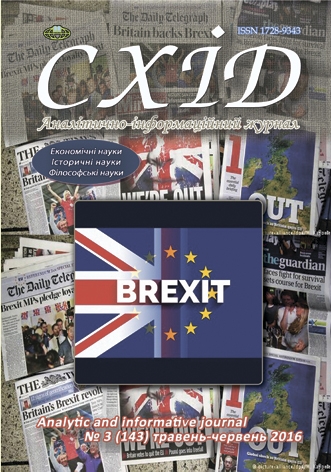Economic systems: scientific cognition methodology and classification criteria
DOI:
https://doi.org/10.21847/1728-9343.2016.3(143).74824Keywords:
basis and superstructure, economic system humanistic constituent, socioeconomic formation, civilization, economic system, economic lawsAbstract
The paper explores methodological approaches to determination of the essence and criteria of economic system classification. Among diversified approaches to classification of economic systems two major ones are identified, namely formational and civilizational. Researchers' views of the relation between these approaches are reviewed.
It is reasoned that out of the two methodological approaches to periodization of economic systems the formational one is the most correct technique from the scientific viewpoint. It is more complete compared to the civilizational approach as it allows for all basic and superstructural elements of the economic system. In addition, basing on the method of abstraction in cognition of the essence of the phenomenon under consideration, it identifies its master elements - production forces and production relations. It is known that the main place in the production force system belongs to the man. It is therefore incorrect to consider that the formational approach ignores the man and a humanistic constituent of the economic system.
The development logic of society (social and economic systems) is as follows:
- development of production forces brings about development of economic relations, property relations;
- property relations promote production of commodities through the economic interest;
- development of commodity production results in formation of socially oriented market economy;
- the highest development stage of socially oriented market economy is information economy;
- the economic system of the present-day capitalism undergoes socialization of production relations, which leads to development of immediate social production, to a new socioeconomic formation.
Downloads
References
Seligman, Ben (1968), Key trends of modern economic thought, Progress Publishing,Moscow, 600 p. (rus).
Semenov A.V. (2001), Economy and society: processes of modernization and transformation (theory questions), Narodny uchitel,Moscow, 281 p. (rus).
Halchynskyi A.S. (2010), The economic methodology. Logic update, ADEF-Ukraine, Kyiv, p. 3-17 (ukr).
Zaitsev Yu.K. (2012), Modern approaches in methodology knowledge of patterns and trends of economic systems, in: Scientific notes of Kyiv National Economic University. Vadym Hetman, № 14, Part 2, pp. 3-13, available at: http://ir.kneu.edu.ua:8080/bitstream/2010/4724/1/vcheni_zapysky_14(2)_12_(3-13).pdf (ukr).
Sazhyna M.A. (2011), Scientific bases of economic policy (Economic Thought), Forum: Infra-M,Moscow(rus).
Chukhno A.A. (2006), Works: In three volumes. Volume 2. Information postindustrial economy: theory and practice, Kyiv National University Press, Kyiv, 512 p. (ukr).
Osadchaya I. O. (1991), On the civilizational approach to the analysis of capitalism, Mirovaya ekonomika i mezhdunarodnye otnosheniya, № 5 (rus).
Porokhovskiy A. (2005), National model of economic development, Economy and Management, № 5, pp. 35-44 (rus).
Barkley Rosser Jr., Marina V. Rosser (1996), Comparative Economics in a Transforming World Economy, Irwin, 1996, 488 p. (eng).
Conklin, David W. (1991), Comparative Economic Systems, Cambridge University Press, 427 p. (eng).
Gregory Paul and Stuart Robert C. (2003), Comparing Economic Systems in the Twenty-First Century, Cengage Learning, 558 р. (eng).
Gabriele A. and Schettino Fr. (2007), Market socialism as a distinct socioeconomic formation internal to the modern mode of production, Munich Personal RePEc Archive, available at: https://mpra.ub.uni-muenchen.de/7942/ (eng).
Veremiyenko T. S. (2012), Social and cultural criteria of economic development concepts, Efektyvna ekonomika. Electronic scientific specialized edition, № 5 available at: http://www.economy.nayka.com.ua/?op=1&z=1349 (ukr).
Douma, Sytse W. and Schreuder Hein (2013), Economic Approaches to Organizations, 5th edition, Harlow (UK), Pearson (eng).
Frolov I.T., ed. (1987), Philosophical dictionary, 5th edition, Politizdat,Moscow, 590 p. (rus).
Marx, Karl (1975), Book Synopsis Lewis H. Morgan «Prehistoric Society» in: K. Marx and F. Engels, Vol. 2nd ed, Part 45, Moscow, pp. 227-372 (rus).
Engels, Fridrish (1961), Origin family, chastnoy property and state, in: Karl Marx and Friedrich Engels, Vol. 2nd ed,Moscow, Part 21 (rus).
Rostow W.W. (1960), The Stages of Economic Growth: A non-communist manifesto, Cambridge University Press, available at: http://www.ou.edu/uschina/gries/articles/IntPol/Rostow.1960.Ch2.pdf. doi: 10.1017/CBO9780511625824
Galbraith J. (1976), Economic theory and goals of the company, Progress Publishing,Moscow, available at: http://www.e-reading.club/bookreader.php/70508/Gelbreiit_-_Ekonomicheskie_teorii_i_celi_obshchestva.html (rus).
Raymond, Aron (1967), The Industrial Society. Three Essays on Ideology and Development, The British Journal of Sociology, Vol. 18, 455-456. doi: 10.237/588674
Mochernyi S. V. (2001), Methodology of Economic Research, Svit Publishing, Lviv, 415 p. (ukr).
During the year the number of millionaires has grown inUkraine(01.10.2016), RIA NovostiUkraine, available at: http://rian.com.ua/economy/20150408/365961238.html (rus).
Ukraine’s GDP, available at: http://srtya.bissnes.org/ (rus).
The gap between rich and poor continues to grow (05.21.2015), Russian Service, available at: http://www.bbc.com/russian/business/2015/05/150521_oecd_rich_poor_gap (rus).
Oxfam: richest 1% owns half of global funds (01.15.2015), Russian Service, available at: http://www.bbc.com/russian/business/2015/01/150119_oxfam_wealth_inequality.
Downloads
Published
How to Cite
Issue
Section
License
Copyright (c) 2016 Liana Dmytrychenko

This work is licensed under a Creative Commons Attribution-NonCommercial-NoDerivatives 4.0 International License.
1. Authors bear responsibility for the accuracy of facts, quotations, numbers and names used.
2. Manuscripts are not sent back.
3. The publisher does not always agree with the authors' opinion.
4. The authors reserve the right to authorship of the work and pass the first publication right of this work to the journal under the terms of a Creative Commons Attribution-NonCommercial-NoDerivatives 4.0 International License. This license allows others to distribute (copy) the published work for non-commercial purposes, provided there is mandatory attribution to its authors and a link to the first publication in our journal.
5. The authors have the right to conclude separate supplement agreements that relate to non-exclusive work distribution in the form in which it has been published by the journal (for example, to upload the work to the online storage of the journal or publish it as part of a monograph), provided that the reference to the first publication of the work in this journal is included.

